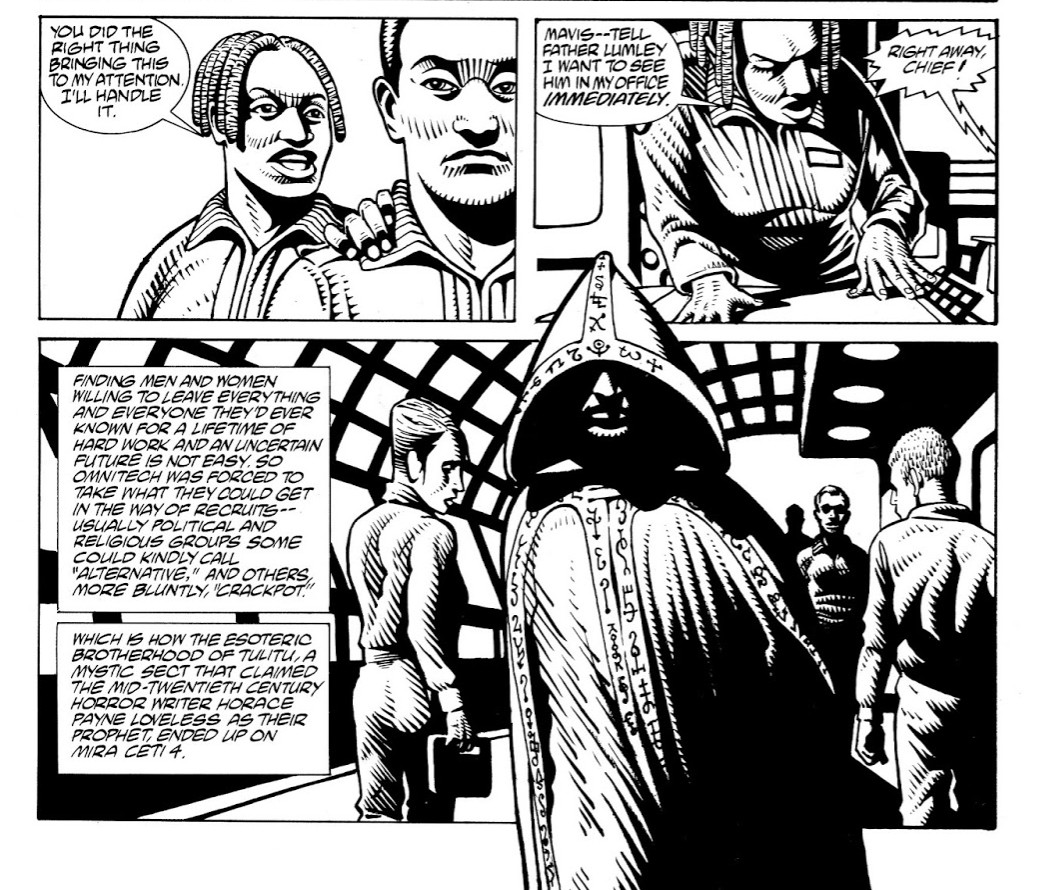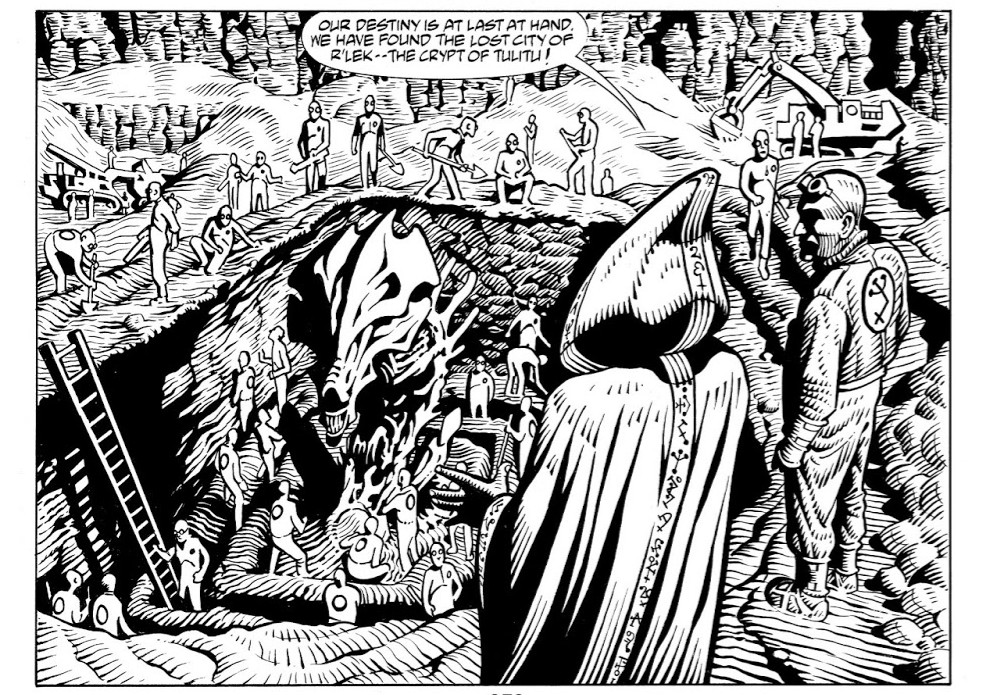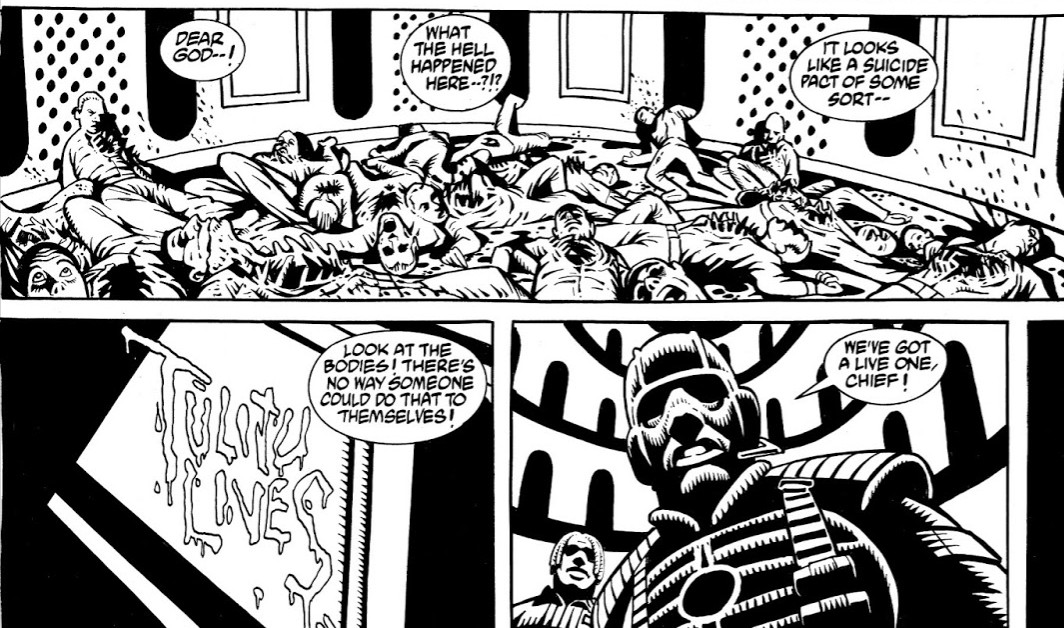Necronomicon,
freely translated, means the types or masks of death,
a museum of the most fabulous abominations and perversions.
The famous writer H. P. Lovecraft
was the first to mention this work,
in his Cthulhu mythology.
Many science fiction and fantasy writers have repeatedly mention this work
but it is only now, in
Giger’s Necronomicon,
that it has become reality for the first time.—Opening statement to H. R. Giger’s Necronomicon (1992 edition)
In 1975, Swiss artist H. R. Giger, Dan O’Bannon, and Ronald Shusett were all working on Jodowrosky’s adaptation of Frank Herbert’s Dune, but the production fell apart. In the aftermath, Dan O’Bannon and Ronald Shusett would revive a script titled Memory, which then became a screenplay, at first under the working title Star Beast, which was eventually changed to the final title: Alien.
In 1977, as Star Wars blew up the box office (and showed the potential for science fiction films, so that 20th Century Fox greenlit Alien for production), Giger’s first major print collection of his work was published. Necronomicon borrowed its title from Lovecraft’s fictional tome, although none of the artworks within are explicitly based off of or depict anything in his fiction; some of the artwork came from the aborted production of Jodorowsy’s Dune. A copy of the book made its way to Ridley Scott, who was directing Alien. Giger was brought on board the production to add his unique aesthetic sense to the design of sets and the eponymous extraterrestrial xenomorph itself. Dan O’Bannon would go on to direct The Resurrected (1991), an adaptation of “The Case of Charles Dexter Ward,” and is sometimes claimed to have been inspired by Lovecraft in writing the script for Alien—although as with Giger, nothing explicitly Lovecraft-related made it into the final film.
The slightness of the connection between Lovecraft and the Alien franchise may be one reason that critics consider Alien “Lovecraftian,” praising its atmosphere and approach as reminiscent of Lovecraft’s work, even as the film lacks any direct connection to the Lovecraft Mythos. As the Alien grew into a franchise with sequels such as Aliens (1986) and licensed comic books from Dark Horse (starting in 1988), more and more creators were drawn into the expanding Aliens mythos—and at least a couple of them were keen on a more definite connection with Lovecraft and his works, if only for a bit of fun.
“Elder Gods” is a 16-page black-and-white comic story written by Nancy Collins, pencils by Leif Jones, inked by John Stokes, and lettered by Clem Robbins. It originally appeared in the one-shot Aliens Special (1997). Taking its lead from Aliens and Aliens 3, the script takes the reader to an off-world colony…but with a twist.

Yes, Nancy Collins penned a tongue-in-cheek parody set in the Aliens franchise, where “Horace Payne Loveless” stands in for “Howard Phillips Lovecraft.” However, it is a loving parody. “Father Lumley” is a reference to contemporary Mythos writer Brian Lumley, and he inherited the mantle from “Father August” who was inspired by August Derleth, “Brother Ramsey” inspired by Ramsey Campbell, etc.; Loveless’ stories include “The Sign of Tulitu” (“The Call of Cthulhu”) and “The Abomination from Ipswich” (“The Dunwich Horror”), and so on and so forth. These are all Easter eggs for fans to spot in what is otherwise a very competent and workable Aliens sci-fi- horror comic; less of a distraction and more that little something extra.

The art complements and expands on the script. “Elder Gods” is one of the few Aliens comics to never be colored, and the stark black-and-white works very well—Leif Jones has always had a talent for the chiaroscuro effect, and with Stokes’ inks they seem to just drink in the light from the page. The symbols of the cult throughout are reminiscent of the magical signs in the George Hay and Simon Necronomicons, but the Giger influence is also clear. Everybody knew what they were doing on this one, and it shows.
“Elder Gods” might be read as a stab at the “cult” of Lovecraft’s readers, or at least the occultists that take the creations seriously. However, there is no ironic twist, no comeuppance where the cultists realize that they’ve made an error. On the contrary, blind as they are to the realities and determined as they may be to try and fit what they see into their worldview…this is still an Aliens comic. What do you think is going to happen?

Horror franchises, whether they be the Cthulhu Mythos or Aliens or whatnot, depend on the the audience knowing more than the characters in the work itself. While there can be plenty of surprises in store, part of the build-up of excitement and a sense of apprehension is recognizing what is going on before the characters on the page or on the screen. A sore throat by itself isn’t scary—but in an Aliens comic… It’s not a question of whether or not the xenomorph is going to appear. It’s when and how. The appeal of these stories isn’t necessarily in bloody bones and grue, but in the million variations on the established concept. Adding a Lovecraftian cult to the mix is definitely a new one.
The closing pages of the story are reminiscent of the transition from Alien to Aliens, where old sins and old threats have been forgotten, disbelieved. That is very Lovecraftian too. Lovecraftian protagonists tend to demand proof before they believe in the unseen things that challenge their worldview; cultists are more accepting, but still try and fit strange alien entities into a very limited, very human perspective. The reality of the xenomorphs is beyond both of them…and isn’t that true of the Alien franchise as a whole? It was a somewhat similar idea expressed in “At the Left Hand of Nothing” (2016) by Jayaprakash Satyamurthy, that the cults of Cthulhu and what not project human attributes and preconceptions onto entities that were never human to begin with.
Like a lot of the Dark Horse Aliens comics, this one has little lasting impact. It’s a little piece of a bigger franchise, often forgotten and overlooked—although it is worth pointing out that the idea of a xenomorph cult is not unique to “Elder Gods,” and who knows but that the story may have played its little part in seeding the idea further.
“Elder Gods” was first published in Aliens Special (1997), and has been reprinted in the Aliens Omnibus Volume 6 (2009) and is available as a digital comic from Dark Horse. Nancy Collins’ other Mythos fiction includes “The Land of the Reflected Ones” (1995) and “The Thing from Lover’s Lane” (1996).
Bobby Derie is the author of Weird Talers: Essays on Robert E. Howard & Others (2019) and Sex and the Cthulhu Mythos (2014).